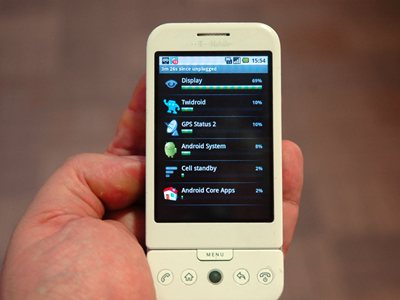Android 1.6: a better experience

Overnight, T-Mobile pushed out the Android 1.6 'Donut' update to my G1. After being asked whether I wanted to install the upgrade immediately or later, I ran the upgrade; the process took the phone out of use for around five minutes, after which it reset and came back with all applications and the majority of settings intact. To date, the only application which seems to have been affected was the Meebo IM client, which had forgotten my Yahoo! IM login details.
Android 1.6 is an incremental update concentrating on usability improvements. The three that make the most immediate impact for most users are the Quick Search Box, changes to the camera software and a new battery usage indicator.

The battery usage indicator is one of the most immediately useful tools and is a small gem of an idea. Hidden away on the 'About phone' settings menu, it gives a graphic display of which applications have been using the most battery power, and then lets you adjust what settings they have to optimise their behaviour. Those settings depend on the application, but you can always remove an app via the screen if you feel it has outstayed its welcome.
Critics of multitasking phones say that power management is the major reason it's a bad idea to run more than one thing at once. This utility is a very strong rebuff to that, especially as it's easy to use and very well thought-out.
The camera updates take what was a rather poor aspect of Android and make it almost acceptable. The major improvements are snappier response time, a simplified interface that makes it easier to switch between video and stills mode, and easier to manage photographs and videos. Unfortunately, there's not much Android can do about the G1's camera hardware, so it remains a device of last resort.
The quick search box is the visible part of a redesigned search system that brings together everything on the phone — applications, data and serivces — and organises them according to usage. Pressing the search key and typing in the word 'weather', for example, brings up my loaded weather applications, search links into Google and Google Maps, a link to weather.com, and further suggestions for online content. Google says that the improved API will encourage developers to integrate their own search functionality into the unified system; we found it fast, useful and a great improvement on the earlier system where you needed to find each search function individually.
Android 1.6 also introduces some major updates to accessibility. If you download the text-to-speech library and the Talkback, Soundback and Kickback applications, the phone speaks menu items and settings as you use the trackball to roll over them. It also signals when it's at a new screen or in a new item by dinging and pulsing its vibrator, although you can configure which of these actions happens.
The speech synthesis is clear and accurate, and in the UK version has a female British accent. Playback speed can be customised from scarily slow to near-gibberish, but it is possible with some practice to use the phone with your eyes closed. This experiment is best done while alone, though, as the experience can be profoundly annoying to anyone within earshot who isn't actually using the device.
Other, minor, aspects of Android 1.6 include better VPN support and a cleaner and better arranged Market.
It's a good update, in the Google tradition of little and often, and makes the Android experience noticeably more pleasant and useful. Such incremental improvements at no cost should increase user loyalty and promote the platform's reputation as being a serious contender in the smartphone marketplace.
Rupert Goodwins